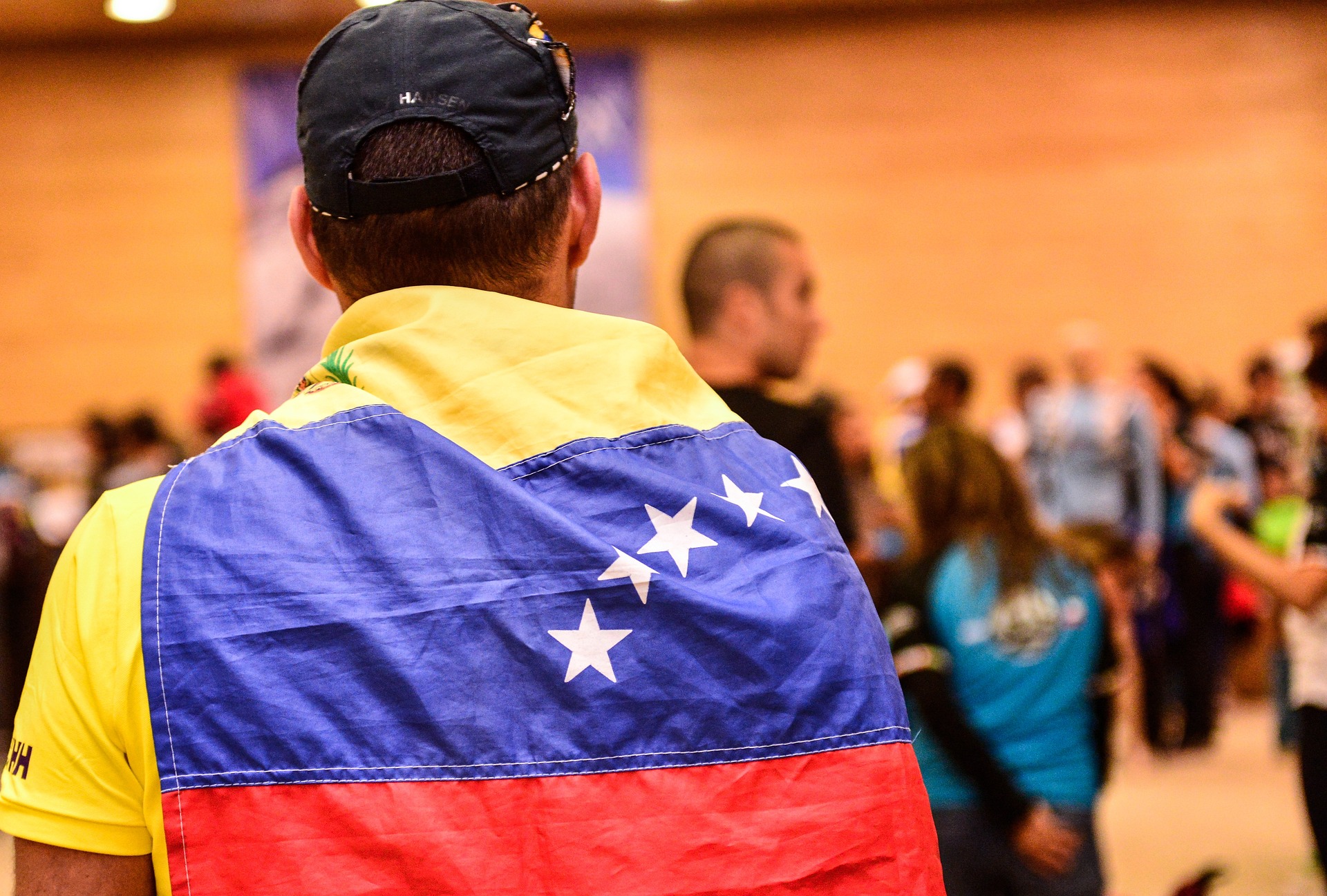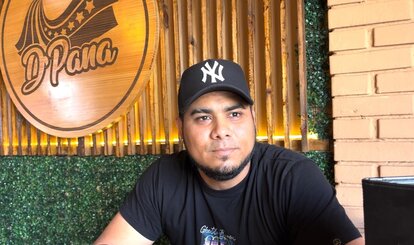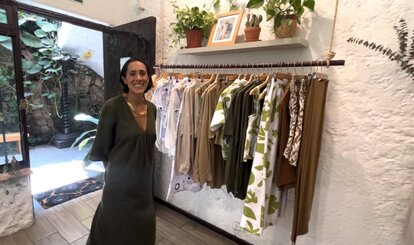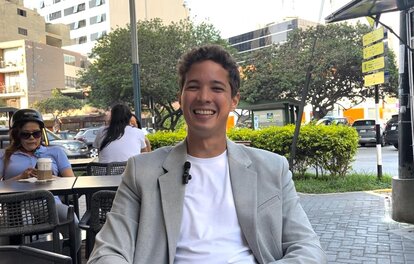Entrepreneurship
Entrepreneurs from Venezuela in Peru and their contribution to the country's economy

Migrant enterprises as an important factor in boosting the local economy
Around 1.5 million Venezuelans live in Peru, making it the second country with the largest Venezuelan migrant population in Latin America, behind Colombia, according to the Interagency Coordination Platform for Refugees and Migrants from Venezuela (R4V Platform).
Faced with difficulties in accessing formal job markets and barriers to validating professional degrees, many Venezuelan migrants have chosen to start businesses as a way to generate income and continue developing their skills.
Migrant enterprises have contributed to energizing the local economy and the growth of the Gross Domestic Product (GDP). The International Monetary Fund (IMF) projects a growth rate of 4.0% for Peru by 2030.
We share the stories of Carlos, Celene, and Leandro, three Venezuelan migrants who have written their success stories through effort and dedication.
Carlos Amundaraín, with his restaurant that has captivated the market with grill flavors, Celene Oropeza with her clothing store, and Leandro Casadiego with his consulting and communications company, are examples of the tenacity and talent of Venezuelan entrepreneurs in Peru.
A piece of tradition with family and friends from the grill
“When I left Venezuela, I told my mother that I would fulfill my dream of having a place to sell food," says Carlos Amundaraín, co-founder of D’Pana Restaurant.
Carlos was born in Margarita, in eastern Venezuela. Due to the political, economic, and social crisis in the country, he decided to leave for Peru in 2017. He arrived on August 12 of that year. “We all came with the dream of finding opportunities in this country,” he says.
When he arrived in Lima, Carlos didn't know what to expect. His first job in the Peruvian capital was at a "cevichería", where he didn't have a very pleasant experience. “I worked for a whole month, but they only paid me for two weeks,” he recalls. However, that didn't stop him from continuing to work to fulfill the promise he made to his mother.
In Peru, until 2019, 76% of Venezuelan migrants and refugees worked in very small enterprises, which tend to be less productive and more informal, and 91% worked in the informal sector, according to the report "Venezuelan Immigration: Characteristics and Macroeconomic Impacts" from that year. Although there is no report with more recent information, there are projections that the informality rate has increased after the pandemic.
This was the reality that Carlos had to experience. Unable to find another opportunity, he had to work selling pastries on the streets of the city. From the sales he managed to make in the day, he paid his fixed expenses and, at the same time, saved up for his business.
With the money he gathered, he bought a cart and adapted it to start selling traditional Venezuelan food. Later on, he joined forces with his brother to adapt a room and offer Venezuelan-style grills. That's how his business started, modest but successful, in 2019.
However, in 2020, the pandemic arrived, bringing with it a series of unexpected challenges. Carlos's business could not open its doors. Despite this, he managed to figure things out during that complex time.
“I would go out to buy at the market and see many people carrying their bags. That's where I started, offering my support, and people paid me for that,” he recalls.
After that, as pandemic restrictions eased, Carlos began preparing food and delivering it to homes or market stalls.
It was almost the end of 2021 when he decided to look for a larger space in San Juan de Miraflores, a neighborhood located south of Lima. By October of that year, he found it. Then, he began writing another chapter of his story, so that his business, D'Pana, could grow.
“I've always had the interest in growing and being able to help my family,” Carlos says, continuing, “Eight months ago, we ventured to start our business in San Miguel. It has been quite a challenge, but we have worked hard. I was able to bring my mom over a year and a half ago, and also bring my other brother. D'Pana has become a family business, where my brothers and I work as co-founders and we are pushing it to grow and make a difference in this country, which has given us this opportunity,” he concludes.

Carlos Amundaraín, cofundador de D’Pana Restaurante.
© Cápsula Migrante
D'Pana has become a family business, where my brothers and I work as co-founders and we are pushing it to grow and make a difference in this country, which has given us this opportunity.
A brand that started in Venezuela and consolidated in Peru
Celene Oropeza, originally from Caracas, did not just pack her clothes when she left her city for Lima on May 8, 2018. In her suitcase, her sewing machine also traveled, a tool that illustrated her passion for fashion.
In Venezuela, Celene had created “Something” in 2015, a brand that aimed to sell second-hand clothing and find a sustainable way of operating. However, due to the country's crisis, she saw no other option but to emigrate.
From Venezuela, she began reaching out to some brands and companies in Lima with the intention of collaborating with them, as Celene is not only an entrepreneur but also a graphic designer and photographer.
During her first year in Peru, she worked as an administrator for a clothing brand, and by the second year, she partnered with a larger brand that had its own physical store. “These jobs allowed me to learn about Gamarra (a commercial emporium considered the largest in the textile industry throughout South America), fabric types, clothing construction, customer service in Peru, and how to manage a store,” she says.
Despite the complexity of the pandemic in 2020, Celene saw it as her opportunity. “I quit the job I had. This wouldn't have been possible without the support of Diego, my boyfriend. During this time, I focused on creating content on social media, and positioning my brand.”
That's how Onism was born.

Celene Oropeza, diseñadora gráfica y fotógrafa
© Cápsula Migrante“For a year and a half, my brand operated in an apartment I rented in San Isidro. From there, I shipped the sales,” Celene recalls.
It's been a year and a half since she moved to a new space, located in the Miraflores district. There, she has two women who manage customer service during the week, in addition to five seamstresses who take care of crafting Onism's designs.
“Starting a business away from home is a challenge. I paid for a safe place because, coming alone to Peru, I didn't want to take risks. And at the end of the month, I remember having only 7 soles in my wallet,” she shares. However, these moments were defining for her to achieve her goals.
“I see everything as a movie, with episodes and chapters. Each situation that happens is an opportunity to learn and grow. I see everything as a learning experience,” she says.
In addition to inspiring other women with her story, she also plans to support foundations dedicated to animal rescue and care in the medium term. For her business, she sees the opportunity to expand with another store in a region of Peru, and another in Venezuela “to always have the chance to return to my country.”
I see everything as a movie, with episodes and chapters. Each situation that happens is an opportunity to learn and grow. I see everything as a learning experience.
I need to create opportunities for myself.
Leandro Casadiego is a social communicator who arrived in Peru from Valencia, Venezuela, on January 18, 2018. Despite the difficulties in finding a stable job, Leandro did not give up and sought alternatives to carve his own path. He first experimented with baking but didn't succeed much.
Nevertheless, his perseverance led him to try again and venture into digital marketing. “The process of starting my own venture was quite fast. When I arrived here in Peru, I went through a series of things that forced me to think, 'I need to do something,'” he recalls of his beginnings.
So, he took a moment to think rationally. “I need to create opportunities for myself, but since I couldn't find them, I said to myself: 'I have to build them myself',” he comments.
Along the way, Leandro met Alfredo Flores, another Venezuelan communicator who arrived in Peru a year before Leandro and later became his partner. Together, they transformed the agency into Crezco Group, a communications consultancy that now provides services to entrepreneurs, both migrants, and locals.
“Currently, what started as an entrepreneurship has also impacted not only the lives of migrants but also locals. It is understanding that migration is an opportunity, not only on a personal level but also for the receiving country,” he proudly comments.
One of Crezco Group's most significant achievements was conducting a study focused on the needs of the Venezuelan population in Peru, addressing various topics such as citizen participation in political decisions, both in Venezuela and Peru. This study was done in partnership with the Konrad-Adenauer Foundation (KAS), in a process that lasted over 5 months and involved a team of nationwide surveyors and data specialists.
This, which started as an entrepreneurship, has also impacted not only the lives of migrants but also locals. It's understanding that migration is an opportunity, not just on a personal level but also for the receiving country.

Leandro Casadiego, comunicador social
© Cápsula MigranteHow does Venezuelan migration contribute to Peru's economy?
According to the survey presented in the report "Panorama on access to public services by the Venezuelan migrant and refugee population: an analysis of employability services in Peru and Colombia," conducted by Equilibrium CenDE and the Friedrich Naumann Foundation, the majority of migrants and refugees work in the informal economy, either in street vending or in jobs without a contract or access to social security protection. According to data from this study, 78% of the employed migrant and refugee population in Peru does not have a work contract, and 64% are not affiliated with health insurance.
Additionally, migrant populations often earn less than local citizens or lack formal work contracts. However, they make a significant contribution to Peru's economic development.
Self-employment has become an important alternative for the Venezuelan migrant population in Peru. Although it allows them to generate income and build opportunities, it also poses various challenges. The study shows a predominantly positive socio-labor perception of the Venezuelan migrant and refugee population. Overall, Venezuelans are considered to have a high level of education and good technical skills. However, what stands out most in the local perception of Venezuelans is their soft skills, such as leadership, responsibility, and quick learning ability.
In 2021, the Venezuelan-Peruvian Chamber of Entrepreneurs and Executives (Cavenpe) and KAS published a study revealing the economic impact of Venezuelan migration in Peru, analyzing the income and fiscal costs associated with the migration phenomenon.
Eleonora Silva, a member of Cavenpe's board of directors, highlights the findings of the report, indicating that despite the pandemic, the Venezuelan population in Peru generated a positive net fiscal impact amounting to S/ 139,805,380 (equivalent to USD 39,944,394).
However, despite this impact and their high level of preparation and productivity, the Venezuelan migrant population in Peru still faces difficulties in accessing formal jobs that match their capacities and professions of origin.
On this point, Carolina Mejia-Mantilla, a senior economist in the Poverty and Equity Practice at the World Bank, explains that in countries like Chile, Colombia, Ecuador, and Peru, Venezuelan migrants are quite young and of working age, which could have an impact on the growth of these nations.
“They are people who can contribute significantly to the economic development of countries or host communities, not only because they are young and of working age but also because they have a high level of human capital or education,” she comments.
For Mejia-Mantilla, the overqualification of Venezuelan migrants represents an opportunity for Peru's development.
“They are employed in jobs where their skills exceed what is necessary, which would create space for improvement in terms of efficiency,” she emphasizes. “If they could be employed at the level of their capacities and in jobs for which their qualifications and education suffice, there would be a greater economic contribution to this population in these countries,” she adds.
How to harness the talent of Venezuelan migration?
The specialist outlines four elements that, for her, are key to harnessing Venezuelan migration. The first is economic inclusion, which should be generated “through regular channels, with labor rights comparable to those of host communities to avoid negative effects.”
Another element is access to basic services such as education and healthcare for the migrant population. This access should be provided through national service delivery systems rather than parallel systems, so that the migrant population integrates with the local population.
Additionally, she indicates that social inclusion of migrants, as the third element, is crucial to harnessing their talent and potential. This inclusion not only enhances the benefits of economic integration but also promotes cooperation between migrants and locals and fosters greater social cohesion.
Lastly, she emphasizes the importance of collecting and analyzing data on migration and migrants' profiles systematically and frequently. This will allow for an updated record of the migrant population and their needs, facilitating the implementation of effective public policies.
Mejía-Montilla's proposal in her report “Venezuelans in Chile, Colombia, Ecuador, and Peru: A Potential Source of Development” is comprehensive and largely aligns with the World Bank's ideas on migration.
Mejía-Montilla's starting point is that migration, including the refugee population, has development potential for host countries. However, to realize this potential, policies that can foster the integration of this community are needed.
The International Monetary Fund (IMF) report, "Regional Spillovers from the Venezuelan Crisis: Migration Flows and Their Impact on Latin America and the Caribbean," suggests that migration flows from Venezuela can translate into a significant increase in GDP in some recipient countries.
According to the IMF's projection, Peru could see a GDP increase of 4.4% in 2030 considering the migration flows to the country, followed by Colombia with 3.7%, Ecuador with 3.5%, and Chile with 2.6%.
Eleonora Silva, a member of Cavenpe, indicates that there is a great opportunity in the country. For some years now, the Peruvian state has been carrying out regularization processes for migrants and refugees.
“The worst thing that can happen with migration is to leave it in limbo, without being quantified or counted. Therefore, these measures help to have a better overview and identify the opportunities that can arise for the Venezuelan migrant population in Peru,” she concludes.
About the authors
Pierina Sora and Héctor Villa are two young migrant journalists based in Lima who promote the Cápsula Migrante project.